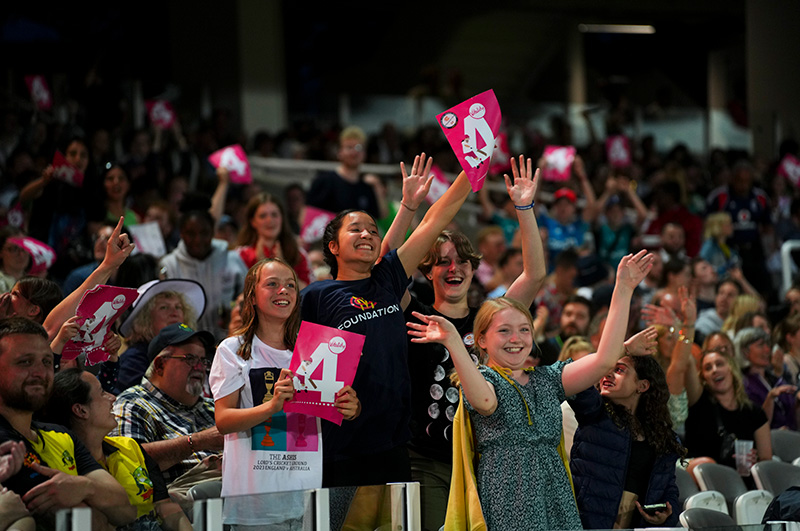MCC exhibits rare cricket scenes by renowned British artist, L.S. Lowry – it will be the first time these artworks will be displayed together.
Take your first glimpse of the artworks as they are installed at The Home of Cricket in this behind-the-scenes video.

Lowry produced around 10,000 pictures, largely depicting crowds, but only a handful relating to cricket, one of which is owned by MCC.
The centrepiece of the exhibition is Lowry’s, ‘Cricket Match; and A Cricket Sight Board, which he declared to be ‘one of my most successful crowd scenes’ in a signed note on the reverse of the canvas (shown exclusively in the video).
The Cricket Match; and A Cricket Sight-Board, 1964 - 1969
Laurence Stephen Lowry, R.A. (1887-1976)
Oil on canvas laid on board
The former 39.3 x 77.4 cm; the latter 24.1 x 77.4 cm
On Loan
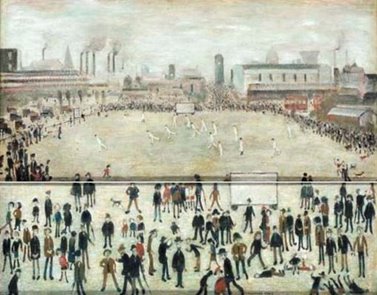
Caption: The Cricket Match, 1964-1969 © The Estate of L.S. Lowry. All Rights Reserved, DACS 2023
Lowry considered this picture to be his most successful crowd scene, reworking it between 1964 and 1969, blending a variety of modern art aesthetics, before eventually splitting it in two.
The influence of French art master Adolphe Valette can be seen in Lowry’s treatment of the crowd, dotted around the top half of the pitch, described using an Impressionist technique known as ‘broken colour’, in which paint is dabbed on the canvas rather than mixed, giving a visual effect of light falling over the figures as they funnel down the road and swirl around the boundary. In contrast, the players, outlined in black and suspended on their toes, show Lowry’s shift away from an Impressionist to a Symbolist approach to time. In the lower section, the naïve and stylised figures, reminiscent of Primitivism, amuse themselves.
The scene was informed and acquired by the chemical manufacturer Alick Leggat, who hung it in the President’s Room at Lancashire CCC during his tenure 1991 – 1992.
A Cricket Match, 1952
Laurence Stephen Lowry, R.A. (1887-1976)
Oil on panel
43.8 x 54 cm
On loan from The Priory Collection
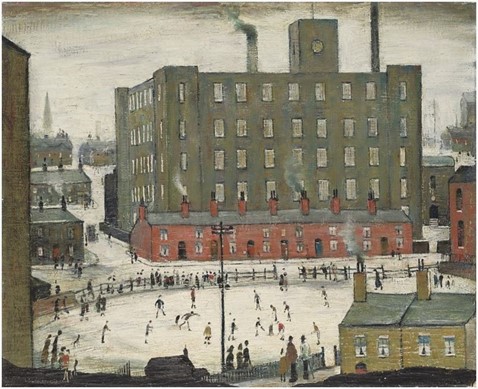
Caption: A Cricket Match, 1952 © The Estate of L.S. Lowry. All Rights Reserved, DACS 2023
The faceless players, reduced to mismatched coloured shirts and black workers boots, are dwarfed by the industrial landscape. The looming clocktower, a symbol of the daily grind, watches over rows of terraced houses. These stylised, characterful dwellings, in turn seem to watch the match (and the viewer), overwriting the barrier between paint and life.
From French Impressionist Adolphe Valette, Lowry learnt to observe daily life. However, unlike his art master and the Impressionists, Lowry only sketched in pencil from life, preferring to paint from memory back in his studio. Many of his scenes are therefore composites, rather than documents, of places around Greater Manchester, where he lived for 40 years.
Despite living close to Old Trafford Cricket Ground, Lowry rarely depicted cricket, preferring football.
The Mill, Lunchtime; a Cricket Match, circa 1940
Laurence Stephen Lowry, R.A. (1887-1976)
Pencil (sketch)
19 x 27.9 cm
MCC Collections
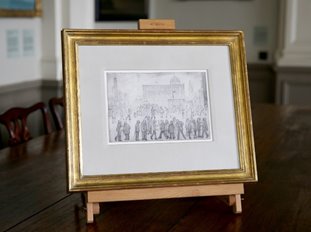
Caption: The Mill, Lunchtime; a Cricket Match, 1940 © The Estate of L.S. Lowry. All Rights Reserved, DACS 2023
A cluster of spectators jostles in the foreground; another group, in the far distance, appears to be laying bets on the outcome; almost none are looking at the match. In the top left of the composition another group is arranged so tightly it becomes hard to identify which stump-like legs belong to which body.
The figures in Lowry’s work are often defined by movement, activity, or intention, like ants working together in a colony dwarfed by an industrial mecca.
A careful observer of people, their relationship to each other and the environment, Lowry comments on the economic and political landscape of industrial Britain in paint, rather than documenting a place or a form. He was a painter of modern life, representing what the camera cannot.
A Cricket Match, 1938
Laurence Stephen Lowry, R.A. (1887-1976)
Oil on canvas
46 x 61 cm
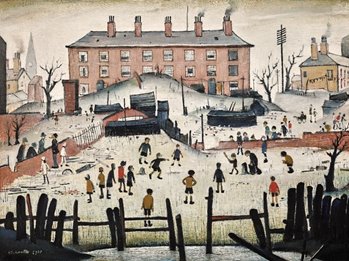
Caption: A Cricket Match, 1938 © The Estate of L.S. Lowry. All Rights Reserved, DACS 2023
The children, playing cricket on a wasteland in winter, appear “savage-like” - a primitive concept in modern western art describing that which is seemingly spontaneous, more honest, than the “civilised” view often seen of cricket being played on a summer’s day in whites on a perfectly manicured pitch.
Childhood and the aesthetics of Primitivism are core themes for Lowry, who observed daily life as if through a child’s eyes, stylizing and narrating figures, consciously moving away from the “academic art” methods he honed at Manchester Academy of Fine Arts between 1905 and 1919, as seen in his technically perfect anatomical drawings.
His “matchstick” men (a term he hated), were his response to the de-humanising effects of 19th-centry industrialization, combined with the poverty he observed and experienced on the streets in Lancashire between the two world wars.
Helen Bradley
Also included in the display are cricket scenes by fellow artist and Lancastrian Helen Bradley (1900–1979): Lowry encouraged her to paint her childhood memories growing up in Oldham. Her pastel palette is in stark contrast to Lowry’s smoky hues, but there are similarities to be found in their slice-of-life scenes and rendering of figures that lack shadow and a linear perspective.
Unlike Lowry, who preferred watching crowds to cricket, Bradley described in handwritten narratives on the reverse of her paintings, her excitement for watching cricket.
The Cricket Match, circa 1970
Helen Bradley (1900-1979)
Oil on board
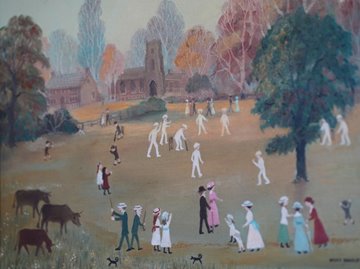
A description in paint (and in ink on the reverse) of artist Helen Bradley’s experiences stumbling across a cricket match as a young girl ‘…Much to Mr Taylor's delight there was a cricket match in progress on the green. The only thing mother, George and I also the aunts didn't like were the cows which decided they'd like to see the cricket match also, and the year was 1906.',
Crowds & Cricket will be on display from May 2023-May 2024 in the Writing Room at Lord’s.
Whether you’re an art enthusiast or a cricket fan - don’t miss this unique opportunity to view these works together by booking a special Cricket on Canvas Tour:
Book a Tour

